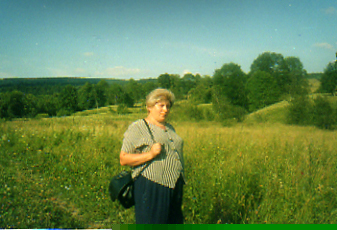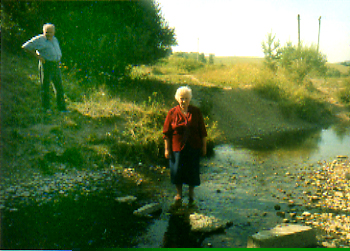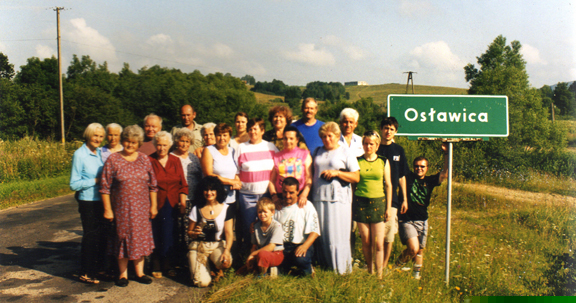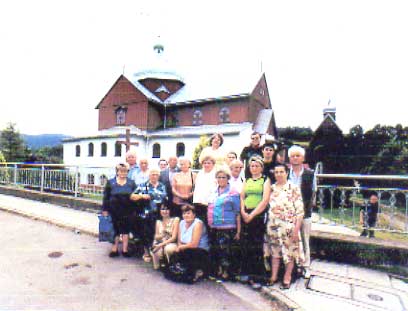Oslawica 2004 page 2
Tatanya writes in 2004:
Return to Oslawica
Every year on July 24 the Lemko Vatra (bonfire) comes to the village of Zdynia. Lemkos who were once driven out of this area by Operation Visla (Vistula), return to honor the homeland of their parents and ancestors. In 2004, a group of 20 people had a reunion at Oslawica village where we had lived with my parents and grandparents. This year I brought my daughter, husband and sisters with me.
We all were awed by how beautiful the landscape was. Where the village used to be, was level and where once was a very nice creek, now it has became narrow and shallow. A train runs past six times a day and the shelter has been preserved to this time. Nearby stands a 2-story building which lives 8 Polish families. They take the train to work in Lypkova and Komancza. We stayed with one Polish woman whose her mother was from our village, married a Polish man and lived in Radokemchi. This woman's daughter bought land in Oslawica and built a hotel for tourists who come to visit this place. She invited me to sleep in her room on divan. She built a nice floral fish pond, which I could see below my window. In the morning, we opened the windows and it was such fresh air; so easy to breathe. I can't breathe this well at home in Ukraine.
From my window, I could see the cemetery, but it is in ruin. Undertakers and caretakes no longer come. The crosses are knocked down by sheep pasturing by the Poles. In 2003 our people came to cut trees, mow the lawn and reset the crosses. They had talked about collecting monies to put a fence around the cemetery and an iron cross, but nothing was done.
We all went to the cemetary. There priest celebrated service for the dead. All prayed, put up wreaths. It rained and people walked barefoot in the mud because the rain was warm.
On this spot where we are standing once stood our church, St. Michael. It was a very nice church. But the Poles broke it up and put stone on the road. Previously they kept a lamb in the church. We are sorry to see now only one ruined bush grows on this spot.



By the building is green grass around flowers in a basin, very beautiful. The owner put two turned boards which were handy for us to rest on. One Polish man who bought 134 hectares talked to us and gave us a tour. On this field which once belonged to my mother, now stand 10 Polish houses with their occupants.
Our field was purchased by a Pole (13429). We lived close to the railroad and the city is beyond our house. We walked all over this place where our mother was born. My parent's house still stands and some Poles live in it. True, it is old, already has 70 years, but pleasant nature and hills circle it. I inquired about our baba, mother's mother. I'm so sorry they chased us from our nice home (Operation Vistula in 1946). Even my husband liked it very much. My sisters remarked, what about this field, woods and bushes. They did not feel the love for this land like I do. I remember, every step I took is dear to me as I reminisce where I had walked and ran. I regret we weren't allowed to return earlier when my parents were still alive. I took home some ground and a stone from the creek as a souvenir.

Professors want to release a book about Oslawica. They've been to Lypkiv and Zybunsko and collected data, photos of old homes and surnames of people who used to live in these villages. The old people have died and the younger ones can't not remember. They probably will have to get data from the archives.
We traveled to Radoszyczi where our great grandmother lived. At the end of the village, on the way to Radoszyczi (?), the Poles built 10 very nice houses. There is such a plaque where appeared Mother of God and took for ourselves water.
I befriended a man of Zybunsko and we talked a bit. He said his parents were from a family Kopkiv from Smilnuka. I told him my grandmother had a mother also from Kopkiv family in Smilnuka. So it appears we are related.
We stayed overnight in Komacza. There is a very nice church which many Ukrainians built and go to it. There was a very nice mass performed in Lemko language. After mass all people met, talked and visited. I very much love to listen to Lemko songs and language. Priest from there assigned us sleeping accommodations in homes, children stayed with Polish children, and we all slept in beds. Was very good. The next day we went to another village nearby-- at least the rain didn't fall. We traveled through Javirnik where your mother was born. I saw everything--everywhere were flowers. And by a house all green and flowers grew, with not any weeds. Very beautiful. Where our parents grew up was truly beautiful.
And then we traveled to Khedivi to Lemko Vatra (bonfire). There were people from entire world: from England, France, Germany, Italy, Canada, USA, Australia...all Lemkos*. They had a beautiful concert. At night they took us to one friend's house where we were able to wash, change clothes and slept on beds. We brought and cooked out own food. Were like ourselves at home.
From Poland, we traveled another six hours at night. Along the road we went to Roman's village Kostarivchi. His house still stands. Arrived at his cousin's brother's house and he hosted us with coffee and tea. We went to church, prayed and then to the cemetary where Roman's baba is buried. Prayed and went home. We arrived at home at 10:00 p.m. The bus dropped me at my house so I didn't have to struggle with anything.
 Plaque commemorating the 50 year anniversary since the Lemkos were chased away from their homelands in Operation Vistula (Action Wisla). Photos of rivers valleys of San and Oslawa in English, featuring landscape, shrines, memories, icon stories
Plaque commemorating the 50 year anniversary since the Lemkos were chased away from their homelands in Operation Vistula (Action Wisla). Photos of rivers valleys of San and Oslawa in English, featuring landscape, shrines, memories, icon stories
*In 1992 the Vatra attracted 10,000 people. Read more about the Lemko Vatra:
http://www.busternus.com/ukraine/83eng.html
Costumes: Lemko Vatra 2004
Lemko Vatra 2003
history of Lemko area: http://www.tccweb.org
http://www.drynoodles.com
http://www.pregner.com/Lemko.htm
http://www.lemko.org/festivals.html
http://www.carpathorusynsociety.org
Text in Polish: http://www.lemkounion.republika.pl/

Oslawica reunion July 24, 2004
Early history and current travel to Oslawica, museums and national parks in the area.
Polish site about Resettlement of villages:
http://www.poprad.colnasprava.sk
The web site is in Slovak language. The column headings are:
Commune Name ........................Village and Settlement Name
In Poland, powiats are divided into communes (groups of communities). The second column identifies the commune name and the far right column (it is divided into two columns) provides the villages and settlements that comprise the commune. The largest community in a commune is typically the center (capital) of the commune, thus the name of the that place is the commune designation.
Lavrentiy
Residents of Oslawica* from Lemko Surnames cited by Krasovs'kyj from 1787 Austrian Cadastral Records
1. Antonin / Antonyn
2. Babiak (7 families)
3. Barna (3 families)
4. Basian / Basjan (2 families)
5. Berdal / Berdal'
6. Bloszczak / Bloshchak ( 3 families)
7. Breczak / Brechak ( 2 families)
8. Wasylow / Vasyliv
9. Wyluczka / Vyluchka
10. Wyslocki / Wislocki / Vyslots'kyj
11. Woluka / Voluka ( 2 families)
12. Hawrylo / Havrylo
13. Hampala
14. Ginslar / Ginsljar (3 families)
15. Hryckiw / Hryts'kiv
16. Guryk (2 families)
17. Denys / Denis / Dinis (4 families)
18. Dziura / Dzjura
19. Durniak / Durnjak
20. Iwaniszyn / Ivanyshyn (2 families)
21. Klim / Klym
22. Kuziemko / Kuzemko (2 families)
23. Machora / Makhora
24. Moskal / Moskal'
25. Nester / Nestor / Nescior / Nester (2 families)
26. Pankow / Pankiv
27. Rudyk
28. Sawka / Sauka / Savka
29. Saranczyn / Saranchyn
30. Seketa ( 2 families)
31. Semaniszyn / Semanyshyn
32. Senkiw / Senkiv
33. Siwak / Syvak ( 2 families)
34. Spiszak / Spishak
35. Surko
36. Terkal / Terkal' ( 2 families)
37. Tyrpak ( 5 families)
38. Faytasz / Fajtash ( 3 families)
39. Chopta / Hopta / Khopta ( 2 families)
40. Cap / Tsap (4 families)
41. Cudyk / Chudyk
42. Szarak / Sharak (4 families)
43. Szczawinski / Shchavnys'kyj ( 2 families)
44. Jurkow / Jurkiv
